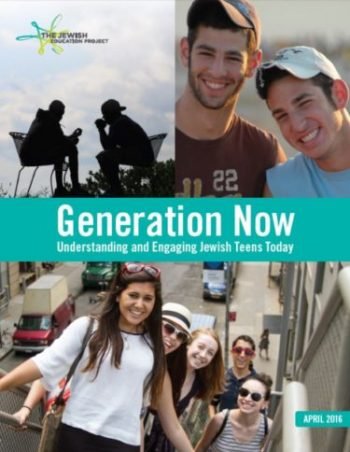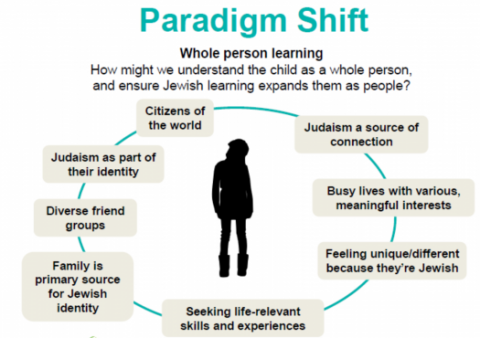Generation Now: Understanding and Engaging Jewish Teens Today
Originally published on eJewishPhilanthropy

Unveiling new research that offers 14 outcomes Jewish teen initiatives can strive to achieve
Part 1 of 2
As the field of Jewish education evolves, more funders, organizations, practitioners, and families want real answers to a seemingly simple question: Are our efforts achieving results? The days of merely counting individuals walking through a door are, thankfully, over. We have moved on from the narrow discussions focused solely on “reaching” individuals. This evolved thinking by nearly all stakeholders in the field is a welcome development, particularly in the area of teen Jewish education and engagement.
Yet, until now, the field has had no uniformed way across organizations and initiatives to measure the success of our Jewish teen initiatives.
This void, and challenge, has been a focus of The Jewish Education Project – through our work as head of the National Incubator for Community-Based Jewish Teen Initiatives – for two and a half years. Over all the years, after all the funding, and even with all the teen initiatives, the field, collectively, had no common outcomes that we strived to achieve and measure ourselves against. Now, “we” do.
Commissioned by the Jim Joseph Foundation, Lippman Kanfer Foundation for Living Torah, the Charles and Lynn Schusterman Family Foundation, and The Marcus Foundation, the new report, Generation Now: Understanding and Engaging Jewish Teens Today is the result of years of research and efforts in Jewish teen education and engagement. The impetus for the new report can be traced back to the Jim Joseph Foundation’s 2013 report, Effective Strategies for Educating and Engaging Jewish Teens, and the subsequent funder collaborative that resulted.
Now, following the collaborative work of our own researchers and a team of evaluators from Rosov Consulting, The Jewish Education Project is excited to unveil shared outcomes, indicators, and measurement tools that will gauge Jewish education and engagement among teens participating in Jewish experiences. We believe these mechanisms will have major ramifications for all elements of teen Jewish education and engagement – from the funding and design of initiatives to the practitioners who interact directly with teens.
Through a comprehensive qualitative research process – including digital ethnographies, 16 in-person focus groups with teens from Atlanta, Boston, Denver, and Los Angeles, along with other research – we began to more fully understand teens and began crystalizing hypotheses around what “success” from Jewish teen initiatives might look like. This work was greatly informed by initial pilot research with teens we conducted in Westchester County, New York.
We unpack many of these concepts below. But, in short, the research informs a new, significant paradigm shift in how we approach teens themselves, and the Jewish teen initiatives offered to them, moving beyond thinking about teens as recipients of Jewish learning experiences. We don’t want to ask, “What can we do to these teens?” We don’t even want to narrowly focus on how we can “empower” teens (a term that, to some extent, has lost meaning).
Rather, the paramount question is: How might we understand and engage the teen as a whole person, and how can Judaism enrich and deeply influence his or her whole life?

And this is what we now put forth to the community: 14 outcomes that can be utilized across organizations and programs to determine if we, collectively, offer teens Jewish opportunities that actually “move the needle” in the areas outlined in the model above. You also can review a more detailed breakdown of these outcomes; each grouped into different categories, painting a multi-level picture and further conveying how these outcomes relate back to the questions.
These Outcomes should finish the following sentence: As a result of a particular intervention:
- Jewish teens have a stronger sense of self.
- Jewish teens feel a sense of pride about being Jewish.
- Jewish teens have experienced learning that has been both challenging and valuable.
- Jewish teens have learned things that enable them to be more active participants in Jewish communities
- Jewish teens learn about and positively experience Jewish holidays and Shabbat.
- Jewish teens establish strong friendships.
- Jewish teens develop strong and healthy relationships with their families.
- Jewish teens develop significant relationships with mentors, role models, and educators.
- Jewish teens are able to express their values and ethics in relation to Jewish principles and wisdom.
- Jewish teens develop the capacity (skills and language) that allows them to grapple with and express their spiritual journeys.
- Jewish teens feel connected to their various communities.
- Jewish teens develop the desire and commitment to be part of the Jewish people now and in the future.
- Jewish teens develop a positive relationship to the land, people and State of Israel.
- Jewish teens are inspired and empowered to make a positive difference in various communities and the world in which they live.
To be clear, we do not expect that every Jewish teen program will address all 14 desired outcomes. Our hope is that teens who engage in multiple programs over the course of their development experience the large majority of these outcomes. And, we seek to move forward helping organizations across the country make use of these outcomes. To that end, after our initial research and interactions with teens, we developed seven “teen centered” questions for funders, organizations, and practitioners to bear in mind when designing Jewish teen initiatives:
- How will this engage me intellectually, physically, and socially?
- How can I share this with my friends? (Jewish and other)?
- How can I apply this to my life?
- How will this help me develop skills that will benefit my life?
- How will this help me feel proud of being Jewish?
- How will this help me be a better citizen of the world?
- How will this help me make the world a better place?
These seven questions can be key guiding principles in shaping the design of initiatives to achieve the desired outcomes.
Already, Rosov Consulting is surveying teens across the country with questions framed by the key findings from the initial research. Not surprisingly, insights gleaned present us with nearly as many questions as answers. Like nearly every other segment of the population, broad strokes fail to clearly capture how teens think about, feel about, relate to, and engage in Jewish life. We will go into greater detail about these findings in our next piece in this series.
Clearly there is a lot to unpack here. We welcome a robust discussion about the use of these outcomes and the findings that helped to inform their development. And we invite you to visit www.jewishedproject.org/resources/generation-now to view a digital version of Generation Now. The report offers a detailed analysis and explanation of the outcomes, the research, the literature review, and other aspects of this work. By digging deeper, we can more strategically fund and design Jewish teen initiatives, measure their success, and, most importantly, offer teens opportunities that address who they are as individuals and who they would like to become.
[See Part 2, “Teens at a Seder with Their Parents Probably Enjoyed Themselves” on eJewish Philanthropy]
David Bryfman is the chief innovation officer at The Jewish Education Project. This research was conducted with his colleagues Jamie Betesh and Justin Rosen Smolen.
